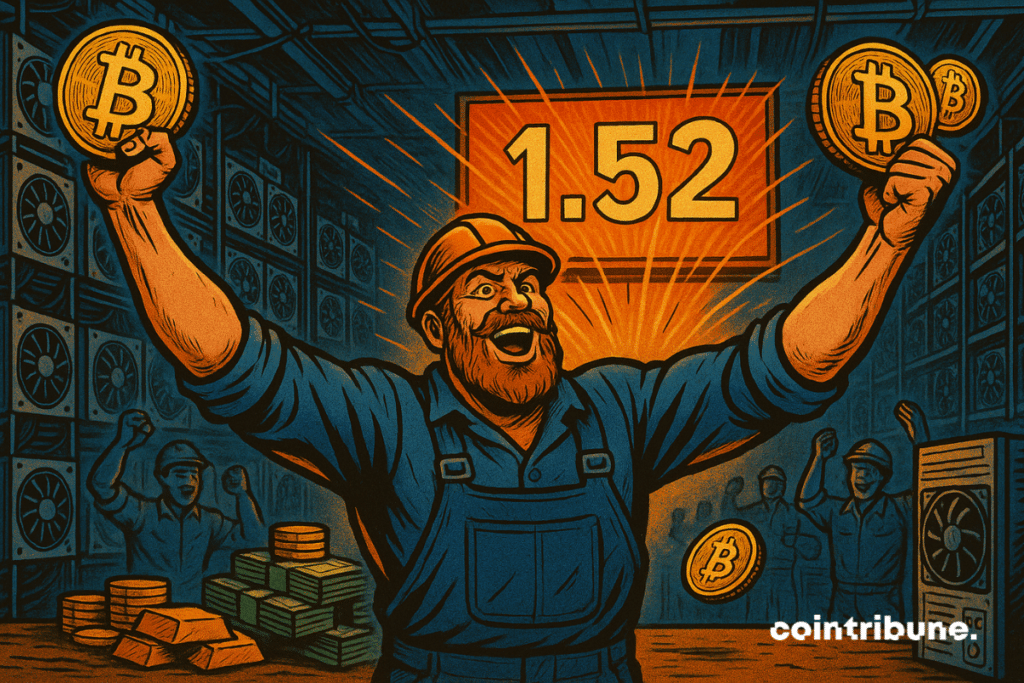Bitcoin Market In Limbo As Mining Profits Rise
When the crypto market wavers, some bitcoin mining companies manage to stand out. In May 2025, despite a tense BTC consolidation phase, mining companies recorded their highest monthly revenues since the April 2024 halving. A remarkable result, achieved in a context of technical correction, where caution dominates trading. This profitability rebound, driven solely by the valuation of bitcoin, highlights the underlying tensions of an increasingly price-dependent model of the asset.

In brief
- May 2025 marks a surge in profits for mining companies, reaching 1.52 billion dollars, their highest level since April 2024, despite an unfavorable technical context.
- Sustained transaction fees, stable hashrate, and rapid adaptation of mining companies explain this unexpected performance during a market consolidation period.
- On-chain fees drop to a historically low level, making sector revenues increasingly sensitive to BTC fluctuations.
- Despite strong revenues in May, hashprice erosion and lack of structural support raise questions about the sustainability of this profitability in the long term.
The mining sector rebounds and records a post-halving record
Despite a collapse of their shares a few months ago, Bitcoin mining companies recorded in May 2025 a monthly revenue of 1.52 billion dollars with 20.09 million dollars coming from onchain fees, setting their best performance since the fourth halving in April 2024.
This record comes in a context marked by an increase in mining difficulty and a stagnation of transaction fees. Indeed, it is the highest monthly level since the last reward halving.
This significant increase in revenues contrasts sharply with the marginal share of transaction fees, which account for only 1.32 % of total earnings, indicating that most profits still come from block rewards.
This performance is based on several conjunctural factors that can be summarized as follows :
- High transaction fees : strong activity on the Bitcoin network generated significant commissions, which boosted the overall revenues of mining companies ;
- A stable hashrate : the network’s computing power did not drop after the halving, ensuring a steady production of blocks despite the reward reduction ;
- Sustained market volume : with 15.8 billion dollars of daily volumes traded on BTC, liquidity remains significant, which feeds fees and benefits mining companies ;
- Rapid sector adaptation : despite the reduction in block rewards, major mining players seem to have efficiently adjusted their operations to maintain their breakeven point.
This picture, observed barely six weeks after the halving, suggests increased resilience of the mining ecosystem in the face of the structural pressure of reward reductions.
However, it will be necessary to monitor whether this momentum continues or if it constitutes a one-off anomaly linked to the technical conditions of May.
An increased dependence on the price of bitcoin
The month of May 2025, although historically profitable for bitcoin mining companies, masks a more nuanced reality. Gains are largely attributable to the rise in BTC price, and not to structural improvements in the network or a return of high transaction fees.
While in April 2024, at the time of the fourth halving, miners had earned 1.79 billion dollars, including 281.47 million from fees alone, these accounted for only 1.32 % of revenues in May 2025.
This contrasts sharply with the 15.73 % fee contribution observed in April 2024, highlighting a marked decline in on-chain activity. Moreover, May’s performance is therefore primarily “largely driven by the appreciation of the bitcoin price rather than by structural changes or an increase in the fees market”.
This trend is also reflected in hashpower profitability indicators. Since May 30, the daily revenue generated per 1 petahash per second (PH/s) has dropped from 54.78 dollars to 52.25 dollars, indicating a slight erosion of the hashprice.
Currently, mining companies earn about 22 % less per PH/s than before the halving, forcing operators to maintain strict operational discipline to preserve their profitability. “Hashprice will need to rise again this month if June wants to match May’s performance”, reflecting increased uncertainty about the sustainability of the current revenue pace.
If bitcoin’s valuation were to stabilize or decline, the lack of support via transaction fees which have fallen to a historic low could make the mining business model vulnerable. This increased dependence on crypto prices demands heightened strategic vigilance, especially for players who must balance their investments in infrastructure while coping with more volatile profitability. In the medium term, only those able to absorb profitability fluctuations will have the capacity to withstand the competitive and energy pressures ahead.
Maximize your Cointribune experience with our "Read to Earn" program! For every article you read, earn points and access exclusive rewards. Sign up now and start earning benefits.
Diplômé de Sciences Po Toulouse et titulaire d'une certification consultant blockchain délivrée par Alyra, j'ai rejoint l'aventure Cointribune en 2019. Convaincu du potentiel de la blockchain pour transformer de nombreux secteurs de l'économie, j'ai pris l'engagement de sensibiliser et d'informer le grand public sur cet écosystème en constante évolution. Mon objectif est de permettre à chacun de mieux comprendre la blockchain et de saisir les opportunités qu'elle offre. Je m'efforce chaque jour de fournir une analyse objective de l'actualité, de décrypter les tendances du marché, de relayer les dernières innovations technologiques et de mettre en perspective les enjeux économiques et sociétaux de cette révolution en marche.
The views, thoughts, and opinions expressed in this article belong solely to the author, and should not be taken as investment advice. Do your own research before taking any investment decisions.